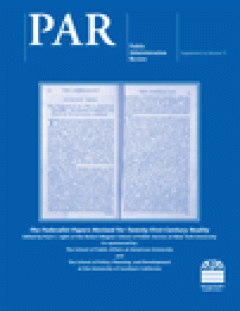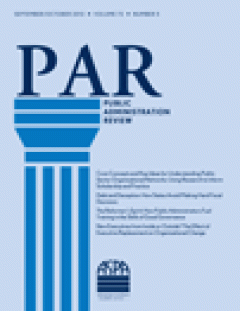Filter by

Federalist No. 51 : Is the Past Relevant to Today's Collaborative Public Mana…
Federalist No. 51 is another of the most recognizable and important of the Federalist Papers, famously arguing that one first must enable government to control the governed, and then oblige it to control itself. The authors suggest that part of this obligation involves effective collaboration within a system of separate powers. They then ask how this “collaboration imperative” can be exercised …
- Edition
- Vol. 71, Issue Suppl. s1, Dec. 2011, pp. s78–s82
- ISBN/ISSN
- 00333352
- Collation
- -
- Series Title
- Public Administration Review
- Call Number
- -

Federalist No. 51 : Is Liberty Guaranteed by Structures?
Federalist No. 51 can be read as a statement of the national government’s dual responsibility to serve the public interest and to preserve liberty. It is built on James Madison’s belief in checks and balances as a method for keeping government’s parts in their proper places. This essay asks whether this gridlock has gone too far in rendering the constitutional design obsolete. Drawing on previo…
- Edition
- Vol. 71, Issue Suppl. s1, pp. s83–s89, Dec 2011
- ISBN/ISSN
- 00333352
- Collation
- -
- Series Title
- Public Administration Review
- Call Number
- -

Federalist No. 67 : Can the Executive Sustain Both Republican and Energetic G…
Federalist No. 67 generally is read as a vigorous defense of the chief executive and contains intense language to alleviate fears of a dictatorial president. However, it also can be read as a much deeper explication of the blend of republican and energetic government. The author examines this defense within the larger stream of Federalist Papers and compares the Anti-Federalist attacks against …
- Edition
- Vol. 71, Issue Suppl. s1, Dec. 2011, pp. s90–s97
- ISBN/ISSN
- 00333352
- Collation
- -
- Series Title
- Public Administration Review
- Call Number
- -

Federalist Nos. 67–77 How Would Publius Envision the Civil Service Today?
Federalist Nos. 67–77 offer a strong defense of the “energetic executive” embedded in the new constitution, which is perhaps best captured in Alexander Hamilton’s famous conclusion that “the true test of a good government is its aptitude and tendency to produce a good administration.” This essay places this basic definition into historical context by reviewing the erosion of the national govern…
- Edition
- Vol. 71, Issue Suppl s1, Dec 2011, pp s98–s104
- ISBN/ISSN
- 00333352
- Collation
- -
- Series Title
- Public Administration Review
- Call Number
- -

Federalist No. 70 : Can the Public Service Survive in the Contest Between Ham…
Federalist No. 70 is widely viewed as a sweeping description and defense of the need for energy in the executive. This essay begins this detailed examination of Federalist No. 70 by comparing Alexander Hamilton’s ideals with James Madison’s more cautionary exposition on separated powers. According to the author, Hamilton’s notion of a public service driven by honor eventually was undermined by …
- Edition
- Vol 71, Issue Suppl s1, Dec 2011, pp s105–s111
- ISBN/ISSN
- 00333352
- Collation
- -
- Series Title
- Public Administration Review
- Call Number
- -

Federalist No. 70 : Is the President Too Powerful?
Federalist No. 70 sets the stage for a powerful chief executive through its emphasis on energy in the executive. This essay reviews the challenges of holding this energy accountable in a republican form of government and concludes that recent presidents have stretched their authorities beyond even the most aggressive defense of the concept. Comparing presidents Abraham Lincoln and George W. Bus…
- Edition
- Vol. 71, Issue Suppl. s1, pp. s112–s117, Dec 2011
- ISBN/ISSN
- 00333352
- Collation
- -
- Series Title
- Public Administration Review
- Call Number
- -

Federalist No. 70 : Where Does the Public Service Begin and End?
Federalist No. 70 argues that presidents will rise above factions through their power to assemble a government composed of highly motivated, accountable officers. The author confronts this assumption through a detailed examination of the heavy use of contractors in today’s administrative state. She documents the challenges and dangers associated with the role of contractors to execute the laws …
- Edition
- Vol. 71, Issue Suppl. s1, Dec 2011 pp s118–s127
- ISBN/ISSN
- 00333352
- Collation
- -
- Series Title
- Public Administration Review
- Call Number
- -

Federalist No. 71 : Can the Federal Government Be Held Accountable for Perfor…
Federalist No. 71 and Federalist No. 76 focus on the level of authority in the executive. This essay reviews the recent history of efforts to measure government performance as a way to control executive performance and then proceeds to a discussion of the weakness inherent in past approaches. The author uses the Government Performance and Results Act and the George W. Bush administration’s Prog…
- Edition
- Vol 71, Issue Suppl s1, Dec 2011, pp s128–s134
- ISBN/ISSN
- 00333352
- Collation
- -
- Series Title
- Public Administration Review
- Call Number
- -

Federalist No. 71 : Does Duration in Office Provide Vigilant Autonomy in the …
Federalist No. 71 contains a strong defense of duration in office as a source of “cool and sedate reflection” by the executive. According to Alexander Hamilton’s argument, duration in office is essential for the vigilant autonomy needed to faithfully execute the laws. The author examines this argument within the context of government regulation, using the recent financial crisis and consumer sa…
- Edition
- Vol 71, Issue Suppl s1, pp s135–s142, Dec 2011
- ISBN/ISSN
- 00333352
- Collation
- -
- Series Title
- Public Administration Review
- Call Number
- -

Federalist No. 72 : What Happened to the Public Service Ideal?
Federalist No. 72 is an oft-neglected defense of the president’s reeligibility for election. However, the paper goes well beyond this issue to basic models of human nature and motivation. James L. Perry’s essay confronts this broad issue as a guide to “a public service ethic.” Like other authors in this special issue, Perry reads broadly through the Federalist Papers in search of a deeper defin…
- Edition
- Vol 71, Issue Suppl s1, Dec 2011, pp s143–s147
- ISBN/ISSN
- 00333352
- Collation
- -
- Series Title
- Public Administration Review
- Call Number
- -

Federalist No. 76 : Does the Presidential Appointments Process Guarantee Cont…
Federalist No. 76 describes the process for appointing the top officers of government, which was seen as essential for recruiting the aptitude and tendency toward good administration. This essay examines the process as it has evolved into a series of Herculean tests of political endurance. Having illuminated the founders’ basic intent for expeditious and honorable appointments, the analysis pro…
- Edition
- Vol 71, Issue Suppl s1, Dec 2011, pp s148–s154
- ISBN/ISSN
- 00333352
- Collation
- -
- Series Title
- Public Administration Review
- Call Number
- -

Federalist No. 85 : Has the National Government Become an “Awful Spectacle”?
Federalist No. 85 offers a synopsis of the overall case for the Constitution. Describing the dangers of a nation without a national government as an “awful spectacle,” the paper provides a rebuttal to the active opposition to ratification. Focusing entirely on the operations of government, this essay examines contemporary challenges to faithfully executing the laws and offers an analysis of com…
- Edition
- Vol 71, Issue Suppl s1, pp s155–s159, Dec 2011
- ISBN/ISSN
- 00333352
- Collation
- -
- Series Title
- Public Administration Review
- Call Number
- -

Managing knowledge assets in a complex business landscape : the relevance of …
In today's complex business landscape it is critical to identify and understand what are the knowledge-based value drivers affecting business value creation. This paper focuses on the relevance of the emotive knowledge as a key knowledge asset shaping organisational capabilities of 21st century organisations. The concept of emotive knowledge is analysed in accordance with a twofold perspective.…
- Edition
- Vol 9, Number 4,December 2011, pp, 279–285
- ISBN/ISSN
- 14778238
- Collation
- -
- Series Title
- Knowledge Management Research & Practice
- Call Number
- -

The impact of outsourcing strategies on companies’ intellectual capital
The aim of the paper is to analyse the effect of outsourcing on the intellectual capital of firms in the current turbulent environment. In particular, the paper will analyse the difference between cost-driven and strategic-driven outsourcing and their impact on human and organisational/relational capital. In addition, the paper will stress the differences in outsourcing of manufacturing and ser…
- Edition
- Vol. 9, No. 4, December 2011,pp, 286–292
- ISBN/ISSN
- 14778238
- Collation
- -
- Series Title
- Knowledge Management Research & Practice
- Call Number
- -

Relational capital inside multinationals
Linking the knowledge-based view, the multinational theory and the intellectual capital-based view of the firm, this paper seeks to identify the main activities belonging to the relational capital of multinationals and the extent to which they contribute to knowledge development and transfer between their different subsidiaries. Six multinational and knowledge-intensive firms placed in Spain ha…
- Edition
- Vol. 9, No. 4, December 2011, pp. 293–304
- ISBN/ISSN
- 14778238
- Collation
- -
- Series Title
- Knowledge Management Research & Practice
- Call Number
- -

Market extension and knowledge management strategies of knowledge-intensive b…
The paper aims at analysing the relationship between the market extension of Knowledge-Intensive Business Services (KIBS) and their knowledge management strategies. The literature emphasizes the strong relationship existing between KIBS and their customers in terms of innovation process and knowledge creation. We argue that the knowledge management strategies – in terms of knowledge codificatio…
- Edition
- Vol. 9, No. 4, December 2011,pp. 305–314
- ISBN/ISSN
- 14778238
- Collation
- -
- Series Title
- Knowledge Management Research & Practice
- Call Number
- -

Knowledge-intensity as an organisational characteristic
The sector of knowledge-intensive business services (KIBS) has a central role in modern economies. However, there are no explicit and generally acknowledged criteria for characterising KIBS or other knowledge-intensive organisations. In addition, the concept of knowledge-intensity has no significant managerial use. This paper aims to widen the existing understanding about the concept of knowled…
- Edition
- Vol. 9, No. 4, December 2011,pp. 315–326
- ISBN/ISSN
- 14778238
- Collation
- -
- Series Title
- Knowledge Management Research & Practice
- Call Number
- -

A model for assessing the coherence of companies’ knowledge strategy
This paper proposes a strategic model for assessing the coherence between companies’ knowledge strategies and their business strategies as well as in their competitive and organisational contexts. In analysing knowledge management literature, we locate three principal strategies: (1) knowledge development (internal or external), (2) knowledge sharing (codification or personalisation) and (3) kn…
- Edition
- Vol. 9, No. 4, December 2011,pp. 327–341
- ISBN/ISSN
- 14778238
- Collation
- -
- Series Title
- Knowledge Management Research & Practice
- Call Number
- -

Intellectual capital and knowledge sharing : the mediating role of organisati…
Healthcare organisations are facing the constant trade off to contain expenditures without sacrificing the quality of patient's care. This challenge to do ‘more with less’ induced healthcare executives to heavily invest in innovations activities in order to increase the efficiency of their organisations. By taking an individual-level perspective, our study focuses on knowledge-sharing behaviour…
- Edition
- Vol. 9, No. 4, December 2011,pp. 342–352
- ISBN/ISSN
- 14778238
- Collation
- -
- Series Title
- Knowledge Management Research & Practice
- Call Number
- -

Unravelling the dynamics of knowledge creation in communities of practice tho…
Drawing on a longitudinal case study of Alpha Chemicals, we use four complexity theory constructs – adaptive tension, enabling leadership, enhanced cooperation, and boundary spanning – to explain the continuous knowledge creation dynamics in Communities of practice (CoPs). Our findings show that the virtual cycle of knowledge creation results from CoPs oscillating between guided and self-direct…
- Edition
- Vol. 9, No. 4, December 2011,pp. 353–366
- ISBN/ISSN
- 14778238
- Collation
- -
- Series Title
- Knowledge Management Research & Practice
- Call Number
- -
 Computer Science, Information & General Works
Computer Science, Information & General Works  Philosophy & Psychology
Philosophy & Psychology  Religion
Religion  Social Sciences
Social Sciences  Language
Language  Pure Science
Pure Science  Applied Sciences
Applied Sciences  Art & Recreation
Art & Recreation  Literature
Literature  History & Geography
History & Geography